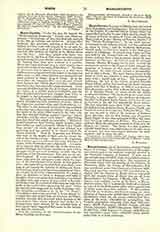

Massa Carrara, Diocese of (MASSENSIS), in Central Italy (Lunigiana and Garfagnana). The city is located on the Frigido, in a district rich in various mines but especially famous for its pure white marble, which the Romans preferred to those of Paros and Pentelicus. Massa Carrara is the “Mansio ad Taberna Frigida” of the “Tabula Peutingeriana”. In the ninth century it belonged to the bishops of Luni, and was confirmed to them by Otto I and by Frederick Barbarossa, though really at that time subject to the Malaspina, counts of Lunigiana. It passed from Lucca to Pisa, was held by the Visconti and the Fieschi, again by Lucca, and was later a free commune under the protectorate of Florence. In 1434, it took the marquis Antonio Alberico Malaspina for its lord; in 1548 the marquisate passed to the House of Cybo, through the marriage of Lorenzo of that name with Riccarda Malaspina. In 1568, Carrara became a principality, and in 1664 a duchy. The most famous prince of the house of Cybo was Alberico I, who endowed his little state with a model code of laws. The daughter of Alderamo, the last of the Cybes, married Rinaldo Ercole d’Este, and by this marriage the duchy became united with that of Modena; in 1806 it was given to Elisa Bacciochi, and in 1814 to Maria Beatrice, daughter of Rinaldo Ercole, at whose death the duchy returned to Modena. The name of Carrara comes from Carraria, a stone quarry. An academy of sculpture founded by Duchess Maria Teresa (1741) has its seat at Carrara in the old but magnificent ducal palace. The fine cathedral dates from 1300. Carrara is the birthplace of the sculptors Tacca, Baratta, Finelli, and Tenerani, and of the statesman Pellegrino Rossi. The see was created in 1822 at the instance of Duchess Maria Beatrice, and its first bishop was Francesco Maria Zappi; it was then suffragan of Pisa, but since 1855 has been suffragan of Modena. The sanctuary of Santa Maria dei Quercioli, founded in 1832, is in the Diocese of Carrara. The latter has 213 parishes, 155,400 inhabitants, one religious house of men, seven of women, and four educational institutes for male students, and as many for girls.
U. BENIGNI

